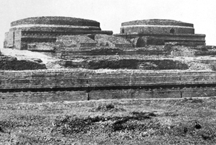Kutila Mura
Kutila Mura stupas stand majestically on top of the highest mound in the northeastern part of the Lalmai ridge near ananda vihara. The stupas are among the best preserved and most attractive monuments in mainamati. In form and style, they differ from those of shalvan vihara and other sites. They represent the traditional style, while Shalvan Vihara and others reveal an evolved style.

The three main stupas here, standing north south in a row, apparently symbolise the 'three jewels' of Buddhism (tri-ratna): Buddha (knowledge), Dharma (morality) and Sanggha (discipline). The foundation of the middle stupa was laid in the form of a Dharma-chakra, its hub being represented by a deep shaft, while the spokes were formed by eight box-chambers where innumerable tiny terracotta and clay votive stupas and sealing were enshrined together with large pieces of a class of fine Buddhist sculptures in soft grey shale. The foundation shafts of other stupas also contained similar relics, but no sculptures.
Evidence from the excavations suggests 7th century as the probable date of the earliest of these monuments; the latest perhaps dates to13th century AD, as indicated by an Abbasid gold coin recovered from an upper level of the site. Five ancient epigraphic records discovered in the Mainamati area refer to two Ratna-traya shrines in devaparvata. It may reasonably be inferred that the Kutila Mura establishment was one of them. [M Harunur Rashid]
